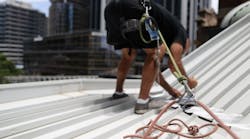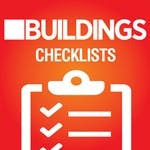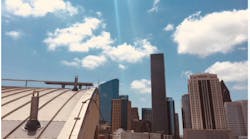Roof safety practices can be easy to overlook for building owners who aren’t dealing with the roof every day the way a roofing contractor would. Recent OSHA rule changes have brought roof safety issues back to the forefront, explains Kirk Dighton, safety manager for roofing contractor D. C. Taylor Co.
Many building owners simply don’t know what the OSHA requirements are. Now that the rules are changing, it’s a great time to refresh your memory on roof safety.
“We’ll do a roof bid and do a pre-construction meeting with the project manager, and inevitably before I leave, we’re talking about permanent fall protection and starting a roof safety survey,” Dighton says. “A lot of times they’ll go ‘You’re right, we need to do this, because my HVAC guys go up there.’ The problem is basically not realizing they have a hazard.”
Make sure you’re protecting your crew on the roof and observing the OSHA roof safety requirements with these tips.
Understand These 6 Common Roof Hazards
Keeping people safe on your roof starts with understanding the six most common hazards that can put their safety at risk.
1. Skylights
“Skylights are deadly,” Dighton says. “They look really nice, they’re pretty from the inside and they let in natural light, but that area is extremely deadly. If you’re working on an HVAC system within 5 feet of a skylight, and you pull on something and suddenly lose your balance, you’re going through it.” Skylights should be covered with netting or cages to protect roof workers in case they fall on the skylight, Dighton explains.
[From IRE: Is It Time to Replace Your Skylight?]
2. Soft decks
You may or may not be aware of soft spots in the roof deck. They’re caused by long-term water damage and can buckle when someone walks on them, creating the conditions for a fatal fall injury.
3. Steep slope roofs
Workers on roofs with a high pitch can fall off the edge if they lose their footing.
4. Lack of edge protection
It’s easy to lose track of how close you are to the edge of the roof, especially when you’re concentrating on looking for roof damage or you’re busy servicing rooftop equipment. Put up a warning line system marking a distance of 15 feet from the roof edge so people know when they’re getting close. Walk pads are another option—they not only mark the perimeter, but also protect the roof from foot traffic damage. However, it’s up to you to make sure people are staying on the walk pad or inside the marked perimeter if you choose not to use warning lines or guard rails.
5. Roof access
OSHA’s revised requirements no longer recognize the classic cage around the ladder as a safe option. Building owners have until November 2036 to comply with this requirement. (Photo: A new OSHA requirement eliminates the old ladder cages and specifies mandatory safety measures for fixed ladders.)
6. Hatch and vent covers
Roof hatches and automatic smoke vents sometimes have translucent covers so they can double as skylights, notes Steve Weyel, product specialist for roof hatch manufacturer The BILCO Company. If your roof hatch fits this description, Weyel recommends making sure it can handle impact in case someone falls onto the dome.
“These products must pass an impact test to ensure that they meet the structural requirements to prevent someone from falling through the dome,” Weyel explains. “There are two types of materials used to construct domes for roof hatches and smoke vents: acrylic and polycarbonate. The acrylic material does not pass the impact test on its own, so a secondary metal security screen or mesh must be placed over the dome after the product is installed. The polycarbonate material is strong enough to pass the test, so no secondary screen is required.”
Have the Right Roof Fall Protection
The right roof fall protection for your crew depends on many factors, including the slope of your roof, the specific fall hazards on your roof and how well your personnel adhere to roof safety best practices. A roof safety survey is a great place to start—it can identify gaps in your workers’ knowledge and places where you need to beef up protective equipment. (See “Roof Safety Surveys” below.)
All roof fall protection falls into two categories: passive and active.
1. Passive roof fall protection, such as a guardrail system, doesn’t require anyone to interact with it or wear it—it just sits on your roof and does its job.
2. Active roof fall protection is designed to be actively used by your personnel on the roof. It includes harnesses, lanyards, anchor points and horizontal lifeline systems that workers connect themselves to whenever they go on the roof.
You need both types of systems “any time you’re working outside the guardrail system,” Dighton says. “People will need to adjust or change a light or a camera system on the edge of the building, and they’ll have to reach through the guardrail. Any time you put your body through the guardrail, you need to have an anchor point and tie off.”
BUILDINGS Checklist
Build Your Roofing File Checklist
As a facilities manager or owner, having organized, updated maintenance and financial records of crucial components of your building is important. Download this free roofing checklist now >>
Remember OSHA’s Roof Safety Requirements
There are several OSHA rules that protect your personnel when they’re on your roof. Here are four of the key requirements to remember, though this is not an exhaustive list. Check out OSHA’s official resources at osha.gov/stopfalls for training tips, videos and more.
1. When to use fall protection
Your crew needs fall protection any time they’re at least 4 feet above the ground unless they’re professional roofers, in which case the requirement starts at 6 feet. If they’re on a scaffold, the rule is 10 feet of height. This protection could be passive or active. Anyone doing roofing trade work needs either 100% tie-off protection (meaning that they’re tethered to the roof at all times), or a set of warning lines 6 feet from the edge of the roof with fall protection any time workers go outside those boundaries.
People doing non-roofing trades on the roof (for example, a facilities manager working on the rooftop HVAC unit) must obey a 15-foot boundary, in which they need fall protection any time they come within 15 feet of an edge or fall hazard.
2. Roof hatches
3. Designated work areas
OSHA allows you to delineate parts of a low slope roof as designated work areas. They can be 6-15 feet from the edge and must be marked with warning lines. Employees can do work in these areas without additional fall protection as long as their work is both infrequent and temporary—for example, changing a belt on a piece of equipment. Otherwise, fall protection is required.
4. Ladders
OSHA no longer allows cages or wells as acceptable fall protection for fixed ladders taller than 24 feet if they were installed on or after Nov. 19, 2018. You have to install a ladder safety system or a personal fall arrest system. Step-through ladders can have flare extensions of up to 36 inches if you install a ladder safety system, and it must have grab bars that extend 42 inches above the access or landing platform.
Creating a Culture of Roof Safety
The requirements can only protect your workers if they use roof safety equipment and best practices every time they’re supposed to. It only takes one accident without fall protection for someone to be seriously injured—or worse.
Dighton recommends auditing personnel to make sure everyone’s doing the right thing when no one is looking. Mistakes may not trigger a firing, but should be learning experiences for everyone. D. C. Taylor maintains a zero-tolerance policy for safety requirements, and people who make mistakes help teach everyone else. On the roof, workers should look out for each other and make sure everyone is following the requirements.
“You have to take care of your people. It’s not about profit over safety or profit over people,” Dighton says. “You have to do the right thing.”
Read more on this topic:




